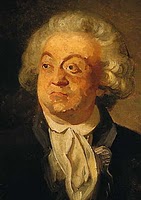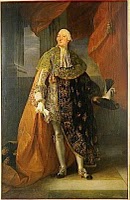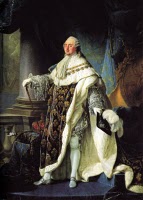The French Revolution Marches Forward
 Saturday, July 4, 2009 at 7:13AM Tweet
Saturday, July 4, 2009 at 7:13AM Tweet Today is Independence Day in the States. The French equivalent is just 10 days away - Quatorze Juillet (July 14th).
In early July back in 1789, things are really beginning to heat up here in Paris! (See previous posts for explanation of preceding events. Start here.)
Vers ailles:
ailles:
Having achieved the support of the King Louis XVI's Finance Minister, Jacques Necker, the National Assembly grows ever more emboldened. The eloquent delegate from Aix-en-Provence and Marseilles, the Comte de Mirabeau, declares, "We are here by the will of the people, we shall only go away by the force of bayonets."
While a moderate who favored political reform by constitutional monarchy, on the British model, Mirabeau's sentiments spark a flurry of political pamphleteering at the Palais Royal.
 At the Palais Royal:
At the Palais Royal:
Pamphlets cause extremists to grow emboldened too. They cry for the immediate dissolution of both the Monarchy and the Church, favoring total control of the French government by the Third Estate.
King Louis XVI and Queen Marie Antoinette are increasingly vilified. The treatment given to the Queen, derisively nicknamed The Austrian Woman, is particularly crushing. Groundless prints and publications give rise to the myth that Marie Antoinette is out of touch with her people, interested only in herself, and a hindrance to the governance of France. She is featured as a winged creature with webbed feet and a spiked tail, or in a flurry of drunken orgies with both men and women. (In fact, at this point she is a known teetotaler and completely devoted to the King and her children.)
Between Paris and Versailles:
Louis XVI continues to send troops to surround Paris, ostensibly to defend the city against the possible recurrence of riots such as that which took place three months before: On 28 April 1789, workers at The Réveillon Walpaper Factory in the St. Antoine district of Paris, fearing pay cuts, destroyed the factory as well as the home of its owner Jean-Baptiste Réveillon.

The Reveillon Factory fire would turn out to be the first of many violent acts still yet to come. Stay tuned.
Images:
Painting of Comte de Mirabeau, courtesy of Wikimedia Commons.
Print of Marie-Antoinette as a serpent, courtesy of http://chnm.gmu.edu/revolution/.
Painting of the Reveillon wallpaper factory riot, 28 April 1789, courtesy of Wikimedia Commons.
Sources:
Fraser, Antonia. Marie Antoinette: The Journey. London: Phoenix Paperbacks, 2001.
Horne, Alistair. Seven Ages of Paris: Portrait of a City. London: Pan Books, 2003.
Jones, Colin. Paris: Biography of a City. London: Penguin Books, 2004







 They did this in the king’s own indoor tennis court where they were forced to convene after the king kicked them out of his meeting. And they swore, in the
They did this in the king’s own indoor tennis court where they were forced to convene after the king kicked them out of his meeting. And they swore, in the  On the south side of the river
On the south side of the river 
